Optipedia • SPIE Press books opened for your reference.
Lenslet Arrays
Excerpt from Field Guide to Illumination
Imaging illumination systems, whether single- or double-lens systems, paraboloidal reflector and lens systems, or single ellipsoidal reflector systems, all suffer from possible nonuniformities in intensity (and consequently also in irradiance). These are due, among other causes, to possible nonuniformities in the source as well as obstructions such as filament support wires, gas discharge electrodes, and LED heat-sink structures.
These nonuniformities can be smoothed out by using a lenslet array, an array (usually 2D) of small lenses. Typically, the arrays are used in pairs. In the diagram below, the dotted purple lines show the marginal rays for one of the lenslets in the first array; the black dotted lines show the marginal rays for the corresponding lenslet in the second array.

In this configuration, the source is imaged by each lenslet of the first array into the corresponding lenslet of the second array. Each lenslet of the first array is imaged onto the entire target. This overlaying creates uniform illumination of the target. In effect, the lenslet arrays create multiple Köhler illumination systems, all superimposed on the target.
Lenslet arrays are generally designed using illumination design software. |
A. V. Arecchi, T. Messadi, and R. J. Koshel, Field Guide to Illumination, SPIE Press, Bellingham, WA (2007).
View SPIE terms of use.
Non-Member: $42.00

